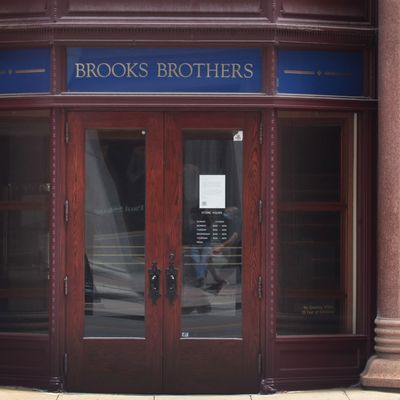
Like a lot of men, I used to shop at Brooks Brothers. Founded in 1818, it’s the oldest U.S. clothing brand in continuous operation, and it leans into conservatism, selling suits that look high quality without being terribly noticeable. A Brooks Brothers suit says “I’m a business person,” and when I was first working, that was something I wanted to telegraph. But I stopped shopping there about a decade ago. Since then, some of the long-run trends that caused me to take my business elsewhere made Brooks Brothers financially vulnerable. Now, like J.Crew before it, the coronavirus crisis has tipped the company into bankruptcy.
Well before the pandemic, the men’s suit industry had been in trouble thanks to America’s increasingly casual workplaces. Total annual sales in the U.S. amount to only around $2 billion, and they have been falling gradually as men wear suits less frequently and need to buy new ones less frequently. These days, when I need a suit, I buy it at Suitsupply, a Dutch retailer that entered the U.S. market about a decade ago and is a little cheaper than Brooks Brothers, with more fashionable tailoring. But I mostly don’t buy suits at all, simply because I don’t wear them very much. I once frequently wore suits to meetings; now, they mostly sit in my closet, unless I have a wedding or funeral to attend.
Brooks Brothers is more than just suits — The Wall Street Journal notes that tailored clothes only make up 20 percent of the company’s sales. But even the company’s more casual clothes are oriented toward use at work, and in the non-tailored clothing market, Brooks Brothers faces a much wider set of competitors and does not benefit from the same strength of the brand that it does on suits.
The COVID-driven closure of offices has further reduced demand for dress attire overall. My husband and I recently sent out dry cleaning for the first time since March; it turns out you can get a lot of wear out of a dress shirt between cleanings if you only put it on for 20-minute TV appearances and Zoom calls. But it’s not just that men aren’t dressing up right now. If and when we do return to the office, we will have clothes in the closet that haven’t been subject to wear, and we won’t need to replace them as soon as we might have otherwise.
The shift toward casual attire may also be one of those preexisting trends that the crisis accelerates. I am skeptical that there will be a large increase in full-time work-from-home arrangements, but I do find it likely that more people will work from home for more of the week, having found ways to get by doing so throughout the pandemic. Since I don’t expect men to wear suits around the house (even Zoom-call attire has been getting more casual as we have settled into virtual work), that could mean a permanent reduction in sales for suits and even for business-casual attire. One silver lining for makers of men’s suits could be that some men who have put on weight during the pandemic will need new, larger suits when it finally ends. On the other hand, in some industries, they just may start wearing sweatpants to the office. (Did I mention that America’s workplaces were becoming increasingly casual?)
So that’s what’s working against Brooks Brothers: a powerful, pre-pandemic trend away from its products; a crisis that forced store closures and caused a sudden, sharp drop in demand; and an uncertain outlook for that demand rebounding, even when economic and social conditions return closer to normal.
Still, the Brooks Brothers brand likely won’t go away. The market for men’s suiting will continue to exist, even at a smaller size, and so the bankruptcy is expected to result in the brand’s continued operation under new ownership. But its products are likely to take up less space in closets as the way American men dress continues to change.





























